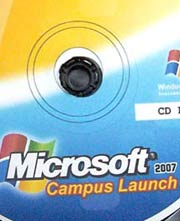Dell Discount – Too good to be true? November 6, 2007
Posted by Tim in Science/Tech.1 comment so far
I’ve been slowly saving up for a new PC, and ordering the parts one by one, mostly from bulk sellers on Lowyat forums.
Nowadays the greatest proportion of the money you spend on the computer is ideally the monitor. Prices have been slowly going down, but the average screen size has gone up – 22″ LCD monitors are basically today what 17″ CRTs were 10 years back.
So you can imagine that I’ve been doing a lot of price and product comparison before shelling out my cash.
One of the manufacturers that I’ve been considering is Dell – they make practical, affordable monitors.
What’s confusing though is how they come up with their online discount schemes. It’s worse than the stock market, the way their prices change.
Something is seriously fishy about their new product line though, specifically their new 22″, the SP2208WFP.
I was checking out the site today because I’d heard of their new 24″ model. I noticed that the SP2208WFP was marked as “RM440 off”.

Sounds like an incredible deal for a new model, right?
The thing is that I’ve been visiting Dell’s site regularly, so the prices have stuck in my mind. I distinctly remember that the price when it was first introduced was also RM1,159.
I tried looking to Google Cache for an old copy of the page, but couldn’t find it at first. After much digging however I found a cached copy of the Singapore Dell page.
Firstly, what the SG Dell site looked like then (the cache retrieval date is 1st November ):
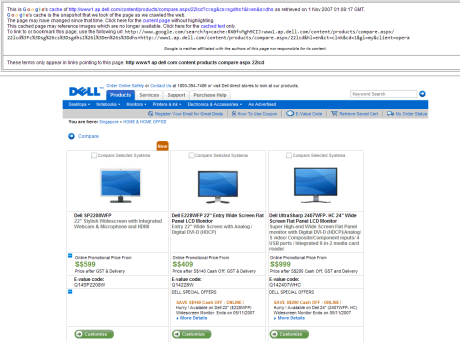
This is what it looks like now (advertising “$70 off” on the unit):

Something’s wrong here… I hope they don’t have a dartboard they use to decide the “discount” on their units.
New Zealand police using a wiki to draft laws October 2, 2007
Posted by Tim in Malaysia, Science/Tech, World.add a comment
For some reason, whenever Malaysia makes international headlines, it’s hardly for flattering reasons – last I checked, the first post on Google News under “Malaysia” is Beyonce cancelling her concert here because she’s too sexy for us.
In contrast, New Zealand recently turned heads for using wikis to gain feedback on the drafting of their new Police Act.
NZ Police Superintendent Hamish McCardle, the officer in charge of developing the new act, said the initiative had already been described as a “new frontier of democracy”.
“People are calling it ‘extreme democracy’ and perhaps it is,” he said.
“It’s a novel move but when it comes to the principles that go into policing, the person on the street has a good idea … as they are a customer,” he said.
…
“The wonderful thing about a wiki is we can open it up to people all around the world – other academics and constitutional commentators interested in legislation – and make the talent pool much wider,” he said.
This is exactly what a modern democracy should be like. The reference to the people as “customers” is just gold.
How about you? Can you think of any ways you would like to change our laws ? :)
Beware Gamecopyworld June 25, 2007
Posted by Tim in Science/Tech, Trends.2 comments
One of my resolutions as a new wage-earner :) is not to buy pirated software, or at least as sparingly as possible.
The foremost reason is to support game companies, especially the small ones which need the money. Felt guilty about the fate of Troika and Interplay especially.

Another reason is that there’s strong reason to believe that all the fake DVDs you buy and install don’t come with unrequested “extras”. It’s like eating food without knowing where it came from. I doubt the syndicates producing the DVDs are using the profits for charity either. I’m not saying that software prices aren’t expensive; they ARE. Imagine the cost of a movie ticket in Malaysia being converted directly – would you pay 3.4 * 8 = RM27 to watch a movie? I don’t think so. So it’s no surprise when people say “no f***ing way!” when they see a game costing RM150-RM200 – but at least if you wanna pirate something, download it; don’t buy it.
Here’s an article from CodingHorror.com listing the stuff GameCopyWorld.com (how many of you have been to this site, hmm?) tries to do to your PC the minute you surf there.
Webroot SpySweeper detected the following spies after allowing the installer to run over night.
Virtumonde
Visfx
ZenoSearchAssistant
PurityScan
Trojan Downloader Matcash
Trojan-Downloader-Zlob
BookedSpace
Trojan-Downloader-WaveRevenue
Trojan.Gen
Trojan-Downloader-Prez
MaxiFiles
TargetSaver
Trojan-Poolsv
Trojan-Dropper-Zomavis
Webhancer
Web Buying
Command
Core Adware (CoreAdware is known to use Rootkits {core.sys} to mask its presence.)
Lelong, lelong – Email addresses for sale! May 20, 2007
Posted by Tim in Malaysia, Science/Tech.add a comment
You may know I hate spam. The practice of selling emails is very common, and while definitely unethical, the number of verdicts actually being passed are few and far between – what more in Malaysia!
Which is why this auction from Lelong.com is disgusting:
Here are few smart reasons to purchase the Email Marketing CD from us today:
- Our database is of over 50,000 Malaysian emails and growing daily!!!
- You can run your own email marketing campaign – as frequent as you can – change your email content for different products / services – just relax, the software will send email automatically when setting is done – manual included in this CD
- Our email list – 50, 000 active email list, user check their email daily – Malaysian email (email from all over Malaysia) – targetted group: Managing Director, General Manager, CEO, Executive…
- Our bulk mail sender software – delivers emails at 50 times faster than the conventional SMTP server – filters out duplicate & invalid email – generates a report of successful delivery & undelivered mail – supports HTML format email
- Pricing – RM399 per CD – you are allowed to resell to gain back your RM399 – we will never know if 2 or 3 or even 10 person sharing to buy this RM399 CD for 10 person use
- SPECIAL BONUS: Additional 10, 000 email is giving away for FREE!!! for the order made within 7 days from today!
Starcraft II! May 19, 2007
Posted by Tim in Science/Tech, Uncategorized.add a comment
Yes no kidding.
Link to official trailer torrents
Gameplay footage on Youtube
Main site (Careful, the site is huge: 5mb+)
Press release at IGN
Gamespy article
Discovers Social Bookmarking May 15, 2007
Posted by Tim in Personal, Reviews, Science/Tech, Trends.4 comments
Ok, ok I’m a little late to the party. But for those of you unfamiliar with the concept, think Friendster except instead of sharing friends you share inane bookmarks.
Useful for me because I’ve been piling up a lot of bookmarks and need a place to organize them. Trying to decide between Del.icio.us and BlinkList atm.
Del.icio.us has a (much) larger userbase, useful for finding sites related to your interests. It was also acquired by Yahoo! recently so there’s no chance of it going under, and you can expect updates and features to come regularly.
I like BlinkList’s interface though – more personal. When you add a page to BlinkList, you don’t have to open a new window, and you can view the tags you already have. That’s a nice implementation of AJAX. It also lets you rate and “star” bookmarks so they stand out. If you’re looking for the Boleh spirit, MindValley, the company behind it, is partly based in Malaysia; could also be a reason why BlinkList feels faster for me. Drawback is the smaller userbase.
[Edit] If you want the stats, Del.icio.us has 1,000,000 US visitors and BlinkList about 200,000.
What’s impressive about both is they support Opera well. Kudos! What’s bad is that both don’t let you mass edit bookmarks to say, delete them or make them private. There are several other options that I didn’t try: Furl (ugly GUI), Magnolia (GUI too good, maybe if I had a better connection..), BlueDot (too MySpace-y), etc.
[Update] You can read a more detailed review here.
Surprisingly, Google Bookmarks is pretty lame.
[Update]I’ve settled on BlinkList. You can view my BlinkList here. I’ve also added it to the bottom of my sidebar.
On the subject of socializing, wth is wrong with the BN “bocor” clowns? You don’t need a PR agent to realize a simple, unconditional “sorry” is what’s needed here. Meanwhile, DAP and PKR are happily milking the issue for all it’s worth.
Dawkins, Behe, and TIME’s 100 May 10, 2007
Posted by Tim in Literary, Science/Tech, Thoughts, World.3 comments
I usually read TIME in the library now (it’s $), but their recent edition of the annual Time 100 (Most Influential People in the World) is worth a look.
Slightly US-centric, I don’t agree with some of the names there, and have to admit I know less than half of the names anyway. The interesting thing about TIME‘s 100 is how the list pairs the subjects with the authors. Oprah Winfrey’s entry is written by Nelson Mandela. The article on businessman-turned-philanthrophist Warren Buffet is penned by Melinda Gates. Michael J. Fox authors the section on Douglas Melton, the co-director of the Havard Stem Cell institute. The legendary professional gamer Jonathan Wendel aka Fatal1ty honours legendary game designer Shigeru Miyamoto of Nintendo.
But by far the most interesting pairing for me had to be the piece on Richard Dawkins, the outspoken evolutionist who pioneered the concept of extended phenotypes. The author paired to him? Michael Behe, a leading intelligent design advocate who coined the term “irreducible complexity”. This shocked me enough to immediately buy the issue.
Some online digging brings up Behe’s original, unedited article. He seems miffed at the sections they cut out, though I can’t see that the core of his essay changed any.
What’s baffling is that he is unhappy with TIME for rephrasing his sentences, e.g.: “the Bible advises us [to be hot or cold but not lukewarm]” .
What he first wrote was “Someone once advised us [to be either hot or cold, but not lukewarm.]”
The irony is: wasn’t this precisely what was wrong with intelligent design?
Vista – Character Characteristics May 3, 2007
Posted by Tim in Reviews, Science/Tech.1 comment so far
Warning: techie/artsy territory ahead.
I said in my previous post that despite all its shortcomings, Vista does look good (at least compared to XP) and not just because of pretty glass. Microsoft Typography has been busy, and they’ve come up with ten new fonts for Office 2007 and Vista. You can get a look at all of them here, and more importantly you can download them here.
It’s actually been ages since Windows had decent new fonts – the only one I can remember was the introduction of Tahoma in WinXP.
The Sans Serifs
You’ll probably remember Arial – the default Windows san-serif font in older versions (all article examples taken from Wikipedia):

Easy to read, very no-nonsense, but boring to look at after more than a decade.
Tahoma was the default font for Windows XP, specially designed for computer screens. It’s a cousin to Verdana, also specially designed for screens and meant to be legible even at small sizes (I’m showing Verdana at a smaller size).


Now enter the new Office default font, Calibri. Calibri has a slightly rounded, modern feel. Compare its lowercase a with the other fonts’ for example, Calibri’s is more “laid-back”. Its lowercase  is also unique for a font that’s officially san-serif; it uses the “double-storey” version. Like Verdana, it was designed for the screen in mind, being highly readable at small sizes, but it also looks good in print. I printed a 50-page report with Calibri as the body font and can already smell an uppercase A :). [Update: Yep, top marks!]
is also unique for a font that’s officially san-serif; it uses the “double-storey” version. Like Verdana, it was designed for the screen in mind, being highly readable at small sizes, but it also looks good in print. I printed a 50-page report with Calibri as the body font and can already smell an uppercase A :). [Update: Yep, top marks!]
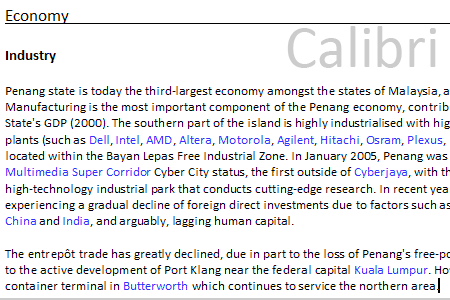
There’s also Segoe UI, the new UI (user interface) font, which means you’ll be seeing it in every MS product. It’s rounded, tall, and widely spaced. Decent enough at small sizes but shines in captions, titles, and the like. I’m not a big fan of the stylized tails though (see the lowercase g, y, j, etc).

Corbel doesn’t look good in large sizes, but IMO it is indisputably one of the best fonts in small sizes (the picture below is in font size 9), retaining legibility and looks cool as well. I like how Corbel plays with the baseline of numbers to make them more prominent. The only quibble is that because of this, the (lowercase) letter o is indistinguishable from the number 0.
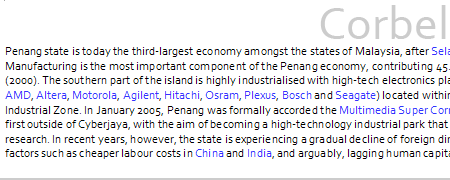

The Serifs
Times New Roman (and its variants) is the first font that comes to mind when it comes to the serif class – not only in Windows, but in most print media. For good reasons, actually: it’s the epitome of readability, and has a decent style. There’s such a thing as overexposure though…
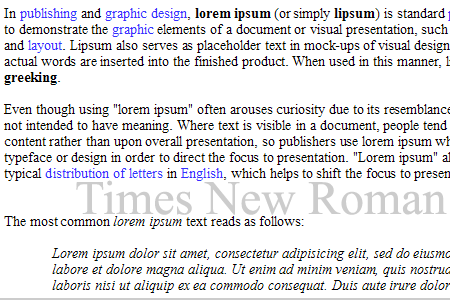
There are also old stalwarts like Garamond, which doesn’t look good on screens but lends an elegant, medieval feel to print media (it’s used in hardcover editions of Harry Potter). I’ve also always been a fan of its italic variant.

Georgia, like Verdana, is a font designed specifically for screens, emphasizing contrast. The drawback is that it doesn’t look as good in print as its other serif brethren.
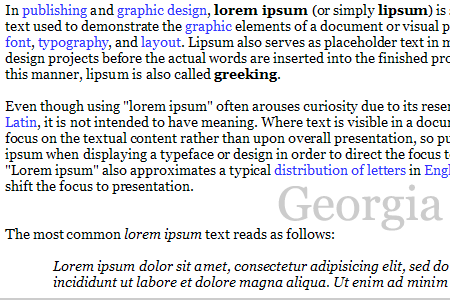
The newcomer to the serif stable is Cambria. It looks like a cross between Times and Georgia: renders well on screens with decent contrast, but not too wide; elegant enough for print.
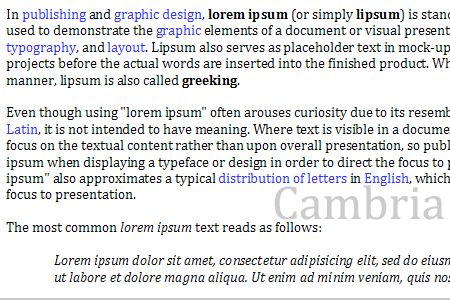
The Monospacies
The letters in fixed width or monospaced fonts all have the same width, which is important in plaintext emails and coding so that the text can be laid out in tabular form. Courier New has been the de facto standard for ages, with a retro, typewriter feel.
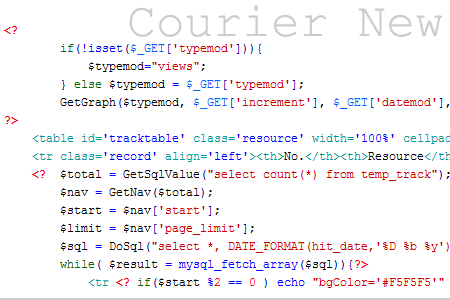
Microsoft’s new alternative, Consolas, is well designed. It’s compact without sacrificing readability at small sizes. Zeroes are prominent; common programming symbols like the semicolon, dollar sign, question mark, etc are easy to pick out.

That’s it
Whew, that took a while. If you missed the link above, you can download most of the new Vista fonts here.
Microsoft didn’t pay me for this but… May 2, 2007
Posted by Tim in Science/Tech.add a comment
I Got Vista Cheap!
MMU’s IT society pulled off a coup recently by persuading Microsoft to launch Windows Vista in MMU: RM20 for a trial version of Vista Business edition. For students in the IT faculty, you could get a product key as well for an additional RM10 – basically getting a full version of Vista for RM30! Not a bad price at all (considering that it retails for RM1130).
Of course, they were obliged to do quite a bit of marketing for MS: Spot-the-car-sticker contests, booths showing off Vista PCs, Xbox games, quizzes and all that. And they had to produce the DVDs and print the covers themselves. But hey, as long as it works, right?
Vista features
It’s been six years since the release of Windows XP, the most recent edition aimed at home users – notwithstanding the lame “Media Center Editions” MS unveiled in between. It seems to be more secure than previous versions, which is good, as well as nifty new features. The downside is that it has a better interface.
How is that a downside? Well “better interface” for MS doesn’t just mean more accessibility, or easier navigation. It’s also a synonym for stuff that bumps up the system requirements without a corresponding increase in productivity (hm, can’t think why MS would want to make its system requirements higher…)
Let’s go through the list of features in the Aero interface, from Microsoft’s page:
- Glass:
Whoopee, windows and borders are transparent. Yes it makes for good eye-candy, when you’re making presentations or showing off your PC. But that’s all it is: a graphical improvement. Serious users care more about how fast the windows appear than what they look like. I also suppressed a laugh at this statement:the new “glass” windows convey a sense of lightweight openness that frees you to focus on your content rather than your environment.
They are referring of course to the blockiness of Luna (the XP interface), which takes up a lot of unnecesary space and why most users (like me) just use the classic look in XP to “focus on our content”. Trumpeting the removal of fat title bars and the like as a feature is like telling us that IE7 is better because it adheres to standards more.
Transparent windows aren’t a new thing either. There are separate programs that enable it, and it’s a feature in a number of other OSes. The only time this is more useful than having windows render faster is when you need to refer to stuff in another window – something tiling, copy/pasting, and having a bigger monitor will do. - Dynamic windows: When minimized, windows animate to their place on the taskbar. Oh come on, this is a very old feature, and is usually turned off anyway.
- High-resolution support: Only useful for people with high-res monitors, could be useful.
- Live taskbar thumbnails: Not new, and only useful if you can’t remember the windows you have open.
- Windows Flip:A more resource-intensive version of Alt-Tab. Ho-hum, also available on XP if you get the Powertoy plugin.
- Windows Flip 3D: An even more resource-intensive, impractical version of Alt-Tab that rips off Mac OS X.
- Smoother-performing desktop: No rendering bugs and fewer crashes. MS is getting good at the “fix-it-and-promote-as-feature” thing…
Now I’m not saying that Vista is all bad, just that I’d prefer more focus on actual (new) features. Everyone has to admit that it looks a helluva lot better than XP. There are several “real” features that you have to give it credit for:
- Support for hybrid hard drives: Hybrid HDDs use a large amount of RAM-like memory as a cache, lessening the need for reading from disks, translating into less time spinning around, which translates into longer disk life and less energy consumption – good for notebook users. But talking about power: be warned, Vista’s Aero interface eats notebook batteries for breakfast.
- ReadyBoost: Lets you plug in a USB memory stick to effectively give yourself more RAM. Very nifty, especially since USB sticks are so ubiquitous now and cheap to boot.
- Improved Remote Assistance: I have to admit I haven’t tried this out myself yet, but if RA works better in Vista, it’ll be great. Invaluable for troubleshooting and helping the less-savvy with tasks without getting them to describe everything to you. The security vulnerabilities in XP’s version made it more often a risk than a boon.
- Internet Explorer 7 is no longer integrated into the OS: Yes, another “fix-and-promote” thing, but notable. OS-browser integration with old IE versions was just asking for security problems, and was irritating as well.
Office 2007
I was at first very unimpressed during the IT Society’s promo of MS Office 2007 (not included in their Vista promo). They were emphasizing features that were either redundant or in the “fix-and-promote” category. The new Ribbon interface for example does a better job at grouping tasks and making them accessible – but that’s more because how convulted the old Office interface was getting, with the gazillion toolbars to wade through. It was highly customizable though. You can in fact build a Ribbon-like interface using the old Office if you have too much time on your hands (click to view the whole thing):
You also have interface improvements like formatting toolbars appearing over text you are editing, and a real-time font-sizing toolbar like the one in Flash. Problem is that these “improvements” are only useful for the users who don’t use computers often. Simply taking the time to memorize keyboard shortcuts works just as well – Ctrl + [ or Ctrl + ] for example does as good a job at resizing your text.
When I dug deeper though, Office 2007 does have features that will be useful for all users. The Autotext and Template selection is vastly improved, and there are global themes you can apply – useful when you want to change the look of a bunch of documents. You can compare between two versions of a document and see the changes that were made. Word also gives you the option of saving into PDF or XML format – very useful!
All Good, But…
The thing is, I can’t actually install my copy of Vista because my computer can’t run it… and no, I can’t sell it to you – we had to sign a very strict agreement.
Tomorrow: Vista fonts!
Sitemeter vs Statcounter April 15, 2007
Posted by Tim in Science/Tech.3 comments
I read a blog today about Sitemeter installing “extra” stuff on the clients that load pages with the Sitemeter code.
Digging a little on the Net found more information: Apparently Statcounter, a competing website counter provider, was approached by an advertiser and offered $ to install data miners in all member sites. From their original post:
A few months back, StatCounter was approached by an advertiser, offered lots of $$$, and asked to include a spyware cookie on all of our member sites…we refused on the spot.
You install StatCounter to track visitors to your site NOT to open yourself and your visitors up to being spied upon by phantom advertising corporations.
It appears, however, that other players in the world of webstats were happy to take up this offer…
We were shocked to discover just today that another well known stats provider is allowing up to 9 cookies to be installed in the browser of every visitor that hits one of their member websites. This means that the provider is making money by transmitting data on you and your visitors to a third party advertiser. Not only that, but to add insult to injury, the cookies are causing the member websites to load very slowly too.
Although Statcounter didn’t name the “other well known stats provider”, it didn’t take long for people to realize that it was Sitemeter, which led to people migrating away in droves. You can read an explanation from Sitemeter here (in the comments section).
To make things more clear for those who aren’t tech-savvy, most stat counters work by putting a cookie in the browsers of everyone who visits your page. This is so that the stat counters can identify unique users. What Sitemeter does is to place nine additional cookies from advertisers in your visitors’ browsers, not to track their visits to your page, but to track their browsing habits, which is valuable to advertising companies.
Sure, you can opt-out from this data mining (which is ironically done by placing another cookie) if you visit a page that they’re not going to tell you about unless you ask, but the point is that in cyberspace, many people value their privacy. In their eyes, Sitemeter has sold them out.

